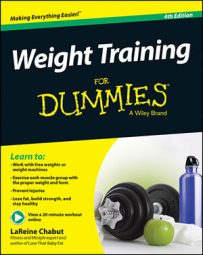With a pull-down, you grab a bar attached to an overhead pulley and pull it down; with a pull-up, you grasp a bar above you and pull yourself up. If you exercise at home, use an exercise band to mimic the pulley machine and do the band lat pull-down.
Pull-downs and pull-ups are grouped in one category because they work your back in the same way. Both types of exercises involve your lats, traps, and rhomboids, but they also rely heavily on your biceps, shoulders, and chest muscles.
If you’re looking to develop a broader back and improve your posture, emphasize pull-downs and pull-ups.
Lat pull-down
The lat pull-down is primarily a back exercise, although your shoulders and biceps also see some action. Try switching grips and attachments to give this exercise a different feel.
When engaging in the lat pull-down, be careful if you have shoulder or lower-back problems.
Getting set
Before you start, sit in the seat and adjust the thigh pads so your legs are firmly wedged underneath the pads with your knees bent and your feet flat on the floor. Stand up and grasp the bar with an overhand grip and your hands about 6 inches wider than shoulder-width apart.
Still grasping the bar, sit back down and wedge the tops of your thighs (just above your knee) underneath the thigh pads. Stretch your arms straight up, keep your chest lifted, and lean back slightly (an inch or two) from your hips.
![[Credit: Photograph by Nick Horne]](https://www.dummies.com/wp-content/uploads/461635.image0.jpg)
The exercise
In a smooth, fluid motion, pull the bar down to the top of your chest. Hold the position for a moment, and then slowly raise the bar back up.
When you’ve completed the set, stand up in order to return the weights to the stack. Don’t just let go of the bar while you’re seated — the sudden release causes the weight stack to come crashing down.
Do’s and don’ts
DON’T rock back and forth in an effort to pull down the weight.
DON’T lean more than an inch or two back as you pull the weight down. Keep that slight lean that you had at the beginning of the movement.
DON’T move so quickly that you jerk your elbows or shoulders.
DON’T bend your wrists.
Other options
Changing your grip: Experiment with the width of your grip and the orientation of your palms to give this exercise a different feel. For example, use the triangle attachment for a triangle-grip lat pull-down. Or use an underhand grip (reverse-grip lat pull-down) and hold near the center of the bar for a pull-down that feels similar to a chin-up.
Avoid pulling the bar behind your neck. Experiment with other attachments of varying lengths and curves, such as the short straight bar and rope.
Assisted pull-up
The assisted pull-up targets your back, with additional emphasis on your shoulders and biceps.
Be careful if you have lower-back or shoulder problems.
Getting set
Set the weight on the machine according to your own body weight before stepping up on the platform of the assisted pull-up machine (sometimes called a Gravitron). Carefully kneel on the kneepads. (Some versions of the machine require you to stand.) Grab the handles that place your palms facing forward and straighten your arms. Pull your abdominals in and keep your body tall.
![[Credit: Photograph by Nick Horne]](https://www.dummies.com/wp-content/uploads/461636.image1.jpg)
The exercise
Pull yourself up until your elbows point down, and then slowly lower your body back down.
Do’s and don’ts
DO relax your shoulders so they don’t hunch up by your ears.
DON’T rock your body to help move you up and down.
DON’T arch your back or round forward.
DON’T stall at the bottom of the exercise. Move steadily until you finish your reps.
Other options
Different grips: Some assisted pull-up machines have a choice of wider or narrower grips. Experiment with your hand placement to see which ones you like best.
Bar pull-up (harder): Using a Smith machine or power cage, set the bar so that it’s securely resting against the stops set in the center of the frame. Grasp the center of the bar with your hands a few inches apart and palms facing you.
Kick your legs out in front of you so that your torso forms a 45-degree angle with the floor. Bend your arms and pull yourself upward until the top of your chest touches, or nearly touches, the bar. Slowly lower to the start position.

